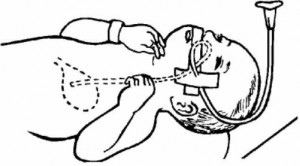a. The growth rate of the premature infant should parallel the expected intrauterine growth rate.
Most immature neonates have feeble, absent or unsynchronized sucking and swallowing reflexes. A great deal of patience is needed when feeding them. A specially made nipple for premature infants may need to be used.
A high proportion of fluid is excreted from the baby through the urine because the baby is unable to efficiently concentrate urine. Intravenous fluid is usually initiated within the immediate hours following birth. Intravenous. glucose is provided to prevent development of hypoglycemia.
b. Maintenance of fluid balance also poses a problem. A high proportion of fluid is excreted from the baby through the urine because the baby is unable to efficiently concentrate urine. Intravenous fluid is usually initiated within the immediate hours following birth. Intravenous. glucose is provided to prevent development of hypoglycemia.
c. The premature infant has a small gastric capacity but a high caloric requirement. Adequate nutritional support may be achieved by providing frequent feedings of small amounts using a high calorie formula.
d. The premature infant regurgitates feedings easily because of the poor muscle tone at the cardiac sphincter. They can only eat small amounts at each feeding. Their heads should be elevated after eating.
e. In addition to high calorie content, the formula is often supplemented with calcium, phosphorous, electrolytes (that is, sodium, potassium, and chloride), and vitamins.
f. When breast milk is required, the mother can pump her breast and the milk can be fed to the baby at a later time.
g. Inappropriate weight gain of the premature infant in relation to caloric intake can indicate problems. Usually large weight gain may indicate excessive fluid retention. No weight gain or a loss may indicate acidosis, sepsis, or malabsorption.
h. The premature infant should be allowed to rest between feedings. The infant tires easily from procedures and will eat better if rested. Each feedings should not last longer than 15 minutes.
i. Gavage feeding (see figure 10-1) may be required until the preterm infant is strong enough for the gradual introduction of bottle or breast-feeding. Before each feeding, stomach secretions are usually aspirated, measured, and the amount/characteristics are documented. If the infant has more than 2 ml of secretions in the stomach prior to feeding, he is probably receiving more formula than can be digested between feedings.

j. When the immature newborn is given intravenous feedings, the fluid should be controlled by a continuous infusion pump to ensure a constant rate and to prevent over feeding. The infant must be carefully observed for the development of hyperglycemia because of the increased amounts of glucose administered. Urine checks are made and the frequency, glucose, detones, and specific gravity are recorded.
